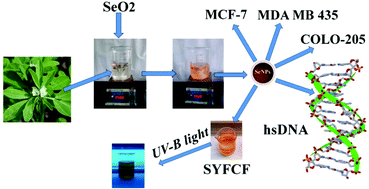hsDNA groove binding, photocatalytic activity, and in vitro breast and colon cancer cell reducing function of greener SeNPs†
Abstract
Selenium nanoparticles (SeNPs) have attracted great attention because of their superior optical properties and wide utilization in biological and biomedical studies. This paper reports an environmentally benign procedure of greener monodispersible SeNP synthesis using the reducing power of Trigonella foenum-graecum extract, characterization and their protective effect against unfolded (Herring sperm DNA) hsDNA. We investigated the anti-cancer activity of SeNPs against MCF-7, MDA MB 435 and COLO-205 cells. The photocatalytic activity of SeNPs was investigated for the degradation of a Sunset Yellow FCF (SYFCF) dye using ultraviolet-B light. The reduction of the Se ion to SeNPs was monitored by ultraviolet-visible spectroscopy (UV-vis). The size and morphology of the SeNPs were characterized by high resolution transmission electron microscopy (HRTEM), X-ray diffraction (XRD), and Dynamic Light Scattering (DLS). The SeNPs were stable, and the diameter was homogeneous at around 5–12 nm. Interactions of various concentrations of SeNPs with hsDNA were systematically investigated by UV-vis, fluorescence, circular dichroism (CD), polarimetry and FTIR spectroscopy under physiological conditions. The results from fluorescence spectroscopy indicated that SeNPs quenched the fluorescence intensity of hsDNA with increasing concentrations. The modified Stern–Volmer quenching rate constant Ksv, binding constant K and binding sites n at different temperatures and the corresponding thermodynamic parameters ΔH°, ΔG° and ΔS° were calculated. Hoechst 33258 and methyl green (MG) site markers, melting experiment (Tm), viscosity measurements and sequence specificity verification by DNA bases clarified that SeNPs bind to hsDNA via a groove site. The rate of photocatalytic degradation of the SYFCF dye in the presence and absence of photocatalysts (SeNPs) was studied using UV-vis, the results showed appreciable degradation of the SYFCF dye. Our results suggested that nano Se can be used as a promising selenium species with potential application in cancer treatment. These nanoparticles were found to be the most active cytotoxic agent prepared in a new green synthesis manner, causing >50% inhibition of MCF-7, MDA MB-435 and COLO-205 cell proliferation at concentrations <10−7 M. Hence these SeNPs could be recognized as promising materials for biomedical applications.


 Please wait while we load your content...
Please wait while we load your content...